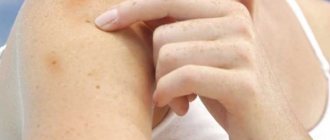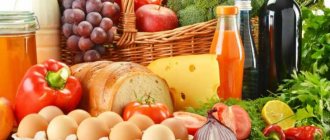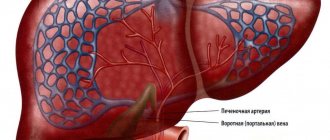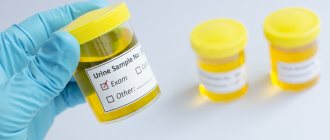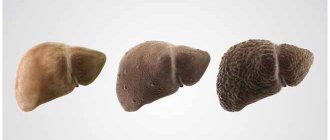Reasons for color changes in analyzes
Normal process
Discoloration of stool and darkening of urine is observed at the stage of pre- or decompensation of liver cirrhosis.
If the liver is healthy and functioning normally, hemoglobin is broken down through the action of enzymes on biliverdin and several other components. Then biliverdin is converted into bilirubin, which can exist free (unbound) in small quantities in the blood. This form of the component is very toxic, but its traces are harmless to the body. Typically, liver hepatocytes are able to neutralize free bilirubin, converting it into indirect bilirubin. In this form, the substance, along with bile, enters the small intestine, turns into urobilin and goes through the bloodstream to the kidneys, from where it is excreted in urine. This is what causes its yellow color. Along with this process, stercobilin is formed in the intestines - a special pigment that colors feces brown.
Deviations in cirrhosis
When liver tissue is damaged, which causes the death of hepatocytes, the functions of the organ are disrupted, and the enzymes necessary to convert bilirubin into indirect form are produced in deficiency. The process of binding a toxic substance and its removal slows down. The main part of the toxin circulates along with the blood throughout the body and is excreted in the urine from the kidneys, which causes its darkening. At the same time, toxic bilirubin does not enter the intestines, stercobilin is not created, and the stool becomes lighter.
Urine color and other characteristics
With cirrhotic liver damage with impaired functionality, the process of bilirubin conversion is disrupted, and its toxic form is transported throughout the body, poisoning it. But nevertheless, it is excreted along with the urine, turning it dark. A characteristic additional symptom is the foaminess of the urine when shaken. Also, urine changes depending on the stage of the disease, as can be seen from the table.
The symptom is pronounced in the morning.
Other characteristic features of urine:
- opacity, turbidity;
- the appearance of visually noticeable flakes with sediment;
- foaming with the appearance of small yellow bubbles;
- a sharp and unpleasant amber.
Return to contents
Features of feces
In addition to being light in color, excrement with cirrhosis changes in consistency, and blood may appear. This condition is a consequence of hemorrhoids - a frequent companion to liver damage due to inflammation of the hemorrhoidal veins. In this case, blood spots may be scarlet and in small quantities. It is typical to appear immediately after defecation. Associated symptoms:
- pain and burning in the anus;
- constipation.
It is possible to develop a more severe and dangerous condition - the appearance of melena (black feces in cirrhosis), which is associated with the opening of internal bleeding. And the masses themselves become liquid and shapeless. The appearance of vomiting “coffee grounds” is specific. Darkening of stool and vomit indicates that blood is being digested in the stomach.
If you detect changes in feces or urine that differ significantly from the norm, it is important to immediately consult a doctor, as this is a signal of decompensation of the disease.
Herbs for liver regeneration
In addition to diet, an effective way to restore the liver is to use the power of medicinal plants. The most effective herbs for the liver are milk thistle, dandelion, and St. John's wort. Liver regeneration occurs thanks to the strongest antioxidant - silymarin, which milk thistle contains in large quantities. Dandelion infusion works as an anti-inflammatory and choleretic agent, and St. John's wort tea promotes food absorption and also protects against the formation of gallstones. An infusion of fennel and plantain also helps the liver function.
Regular use of herbs is a good way to relieve liver intoxication, maintain its normal functioning and cleanse it of toxins.
What is mumiyo, why is it useful, how to distinguish it from a fake, photo
Alcoholic hepatitis: symptoms and treatment
Reasons that can change the shade of tests for cirrhosis
The following factors also influence color:
- Urine:
- the amount of water you drink, which can dilute the pigment;
- time to check - in the morning the urine is even darker;
- a person’s age—lightens as they age;
- products with bright colors;
- medications.
- Kala:
- complications affecting the gastrointestinal tract;
- haemorrhoids;
- internal bleeding;
- varicose veins of any location.
Return to contents
Therapeutic measures
Treatment is prescribed depending on the stage of cirrhosis and the extent of liver damage, the presence and nature of complications. As a rule, intensive drug therapy is indicated together with diet No. 5. It is possible to perform surgery through anastomosis and ligation of the hepatic artery. Self-medication is strongly discouraged due to the severity of the disease. Cirrhosis of the liver is incurable.
The process of formation of feces in the intestines is complex and is associated with the work of the whole organism. Therefore, based on the consistency and color of stool, various pathologies can be suspected. Stool with hepatitis has especially characteristic signs. It often happens that only a change in its color indicates the presence of infection; there may be no other signs of pathology at the initial stage. Therefore, it is important to notice any changes in the body and consult a doctor in time. This will help prevent complications and quickly normalize all body functions.
What is hepatitis
The liver is the largest gland in the human body. The state of the immune system, the digestion process, and the functioning of the nervous system depend on its proper functioning. The liver produces many enzymes, hormones and bile, cleanses the blood of toxins and utilizes some metabolic products. This organ has great self-healing capabilities, but there are pathologies that lead to its irreversible destruction. Among them, hepatitis - viral or chronic - ranks first. These pathologies affect approximately 25-30% of adults.
Hepatitis is a viral disease characterized by damage to liver cells. The pathology is caused by different viruses, which are designated by the letters A, B, C, D and E. The most common are viral hepatitis B and C. This disease is very contagious, so anyone can get sick. And since at the initial stage it hardly shows any symptoms, it is important to know how to identify the disease yourself. If treatment is not started on time, the damage to liver cells will become irreversible. The consequence of this can be serious disruptions in the functioning of the entire body.
Hepatitis A is most common among children and adolescents. This type of virus is transmitted through dirty hands, unwashed food and contaminated water. The manifestations of the disease are initially similar to those of an intestinal infection. With timely treatment, this form of pathology can be cured without serious consequences. Hepatitis B and C are transmitted primarily through blood, saliva and other body fluids. This disease may not manifest itself in any way for a long time – up to six months. But the virus gradually affects liver cells, which over time leads to cirrhosis, liver cancer and other unpleasant consequences, including death.
The liver hurts, how to take care of it
Liver cells have a high ability to regenerate, however, a significant load on the liver makes it increasingly difficult for it to recover. The process of cell death begins to prevail over their restoration. The liver is an important gland that performs serious and vital functions. Therefore, you need to take care of it by leading a healthy lifestyle. As part of caring for your liver, it is recommended:
To protect your liver, you should consider vaccinations. There are currently two available - against hepatitis A and B. Vaccines against hepatitis C have not yet been invented. This is the most dangerous of viruses. It destroys the liver over many years before symptoms such as liver cancer or cirrhosis appear. To protect yourself from this disease, you should avoid places where the skin can be damaged. These are tattoo parlors and beauty salons.
What might the patient's stool look like?
Typically, a healthy person produces 200-300 grams of feces per day. The color and consistency of stool depend on the characteristics of the food consumed, the amount of water drunk, medications taken, and the functioning of the gastrointestinal tract, especially the liver. In healthy people, feces should be dense, well-formed, without impurities and a strong odor, usually of a brownish tint.
The color of stool may depend on the food a person has eaten in the last two days. After all, feces are formed from products that enter the gastrointestinal tract after nutrients are absorbed from them. A reddish tint may appear after eating beets; green stools occur after broccoli or a large amount of greens. It can become light, almost white after a long period of eating fatty foods or dairy products. The color of your stool may also change if you take certain medications or foods with dyes.
The color of your stool may change depending on the food you eat.
Normally, with normal functioning of the digestive system, the color of stool should be brownish. It may be darker or lighter, even a yellowish tint is normal. But a serious change in the color of stool may indicate some kind of health problem. This happens especially often with liver diseases. For example, with hepatitis, stool becomes white or grayish. But don't worry if this happens just once. Stool may become discolored after consuming large amounts of dairy products.
Some medications can also make it white:
Changes
Bilirubin gives stool its brown tint. This substance is processed hemoglobin and is produced in the liver. Bilirubin is one of the components of bile. Getting into the intestines with it, it is converted into a special substance - stercobilin, which has a brown color. It binds to the forming feces and determines their color. The more bilirubin in the bile, the darker the stool.
With hepatitis, liver function is impaired, so the release of bilirubin slows down, and little bile is released into the intestines. This also happens due to blockage of the bile ducts. In this case, bilirubin begins to be released through the kidneys and skin. And due to a lack of the brown enzyme stercobilin in the intestines, the patient’s feces become discolored. Such grayish-white stool is called acholic. It appears with any liver pathology, most often with hepatitis. But stool can also become discolored due to cirrhosis or blockage of the bile ducts.
With hepatitis, the breakdown of fats in the intestines is also disrupted, so the consistency of feces becomes clayey. The stool is greasy, sticky, shapeless, like putty, and is difficult to wash off the walls of the toilet. In addition, the patient's stool has a sharp, specific odor.
More serious liver problems, such as cirrhosis, which is often a complication of hepatitis, can lead to other changes in the color of stool. They turn black due to the presence of blood in the intestines. Such internal bleeding can be very dangerous, so any change in the color of the stool should be a reason to consult a doctor.
If liver function is impaired, stool becomes white and greasy
But first you need to remember what foods were included in the diet in the last two days, what medications were taken. After all, a change in the color of stool may be due to dietary habits. If this condition is not related to diet and does not go away after a few days, it is better to get examined.
Additional signs of hepatitis
White stool in hepatitis is often the only manifestation of this pathology. It indicates serious liver dysfunction. In the initial stages, the disease may no longer manifest itself in anything other than the cessation of the flow of bilirubin into the intestines. If grayish-white stool appears once, there is nothing to worry about. But stool discoloration for several days, if it is not related to medications or diet, should be a reason to visit a doctor.
It is especially important to start treatment as quickly as possible if the grayish-white feces, as in the photo, are accompanied by other symptoms:
Are jaundice and hepatitis the same thing?
- increased body temperature;
- painful sensations in the right hypochondrium;
- yellowing of the skin and whites of the eyes;
- rash, itchy skin;
- frequent nosebleeds;
- dark color of urine;
- indigestion, loss of appetite;
- nausea, vomiting, diarrhea;
- decreased performance, lethargy, drowsiness.
Symptoms of liver disease on the face
Liver disease also causes very characteristic and often unpleasant skin symptoms. Most of these changes are the result of impaired hepatic metabolism. The cause of visible changes on the face and other areas of the skin is protein deficiency and hormonal imbalances.
One of the most common signs is the so-called spider veins. Vascular networks are formed as a result of burst blood vessels. They can be localized not only on the face, but also on the limbs, chest, and abdomen.
With liver diseases, age spots may appear on the face. Red spots may appear on the body associated with chronic alcohol consumption. In addition, the rash may appear all over the body. These are brown or yellow spots.
With liver failure, symmetrical redness may appear on the hands, the so-called palmar erythema, also called hepatic palms, sometimes such rashes can be localized on the feet. Diagnosed with cirrhosis, that is, fibrosis of the liver. Symptoms of a diseased liver also appear on the nails, in this case pigmentation is noted.
This is what liver palms look like (palmar erythema)
Patients often notice itchy skin, which sometimes indicates the onset of cirrhosis. Itching can be observed only on certain parts of the body, most often on the arms, forearms, and legs. Itchy skin can be excruciating. It is associated with cholestasis - difficulty in the outflow of bile.
What to do
If a person passes light-colored stool for several days, it is recommended to consult a doctor. After all, this condition can be a symptom of hepatitis. But it is impossible to diagnose this disease only by external symptoms. Therefore, it is necessary to undergo examination. In addition to examining the consistency and color of the stool, it is also important to determine what color the patient’s urine is. With hepatitis, it becomes very dark, like strong tea. After all, bilirubin begins to be released not through the intestines, but through the kidneys. For diagnosis, blood tests are also done to detect the virus.
When a diagnosis of hepatitis is made, it is necessary to begin specific treatment as early as possible. It should be carried out under the supervision of a doctor, since improper therapy can lead to the death of liver cells and serious complications. Consequences of hepatitis such as cirrhosis or liver cancer can lead to complete loss of liver function and death.
If jaundice appears simultaneously with stool discoloration, this definitely indicates hepatitis
It is simply impossible to return the normal color of stool without curing the underlying disease. Therefore, you need to start with the destruction of the hepatitis virus or with the elimination of other causes of pathology. The doctor prescribes special medications, for example, antiviral drugs, interferon-based drugs, corticosteroids, anti-inflammatory drugs. Usually the acute stage of this disease is treated in a hospital.
Simultaneously with eliminating the cause of the disease, it is necessary to restore liver function. To do this, it is recommended to take hepaprotector medications, for example, Karsil, Gepabene, Essentiale, Rezalut. Products based on glycyrrhizic acid, for example, Phosphogliv, are effective. Choleretic agents, vitamins, minerals, and enzymes are also prescribed.
In case of hepatitis, it is very important to follow a diet that reduces the load on the digestive tract and ensures liver rest. To do this, be sure to exclude alcohol, fats, sweets, smoked foods, and hot seasonings from the diet. It is necessary to increase the amount of liquid, only boil or bake food, it is advisable to chop it well before eating.
In order to recover from hepatitis, you must strictly follow all the doctor’s recommendations. A lifestyle, a gentle diet, and the elimination of bad habits and physical activity will help restore liver function faster. Much also depends on the timeliness of seeing a doctor. To do this, you need to be attentive to your condition and notice any disturbances in the functioning of the body. After all, even a change in the color of stool can become a characteristic sign of a serious pathology.
If stool becomes discolored for a long time, you should be tested for hepatitis as soon as possible. Impaired liver function not only causes changes in the color of stool. This pathology can lead to more serious complications. But this can be avoided by starting treatment on time. The color of the stool will be restored when the flow of bile into the intestines is normalized.
Diet
A disease such as cirrhosis of the liver is very difficult to fight. And here it is important to use all possible treatment methods in order to somehow stop the replacement of healthy organ cells with connective tissue.
Diet in this case is an integral part of therapy. It relieves stress on the liver and helps prevent the development of complications. As a rule, patients with liver cirrhosis are prescribed treatment table No. 5a. In case of ascites development - treatment table No. 10.
The patient must exclude from the diet foods that have a negative effect on the liver. These include all fatty, fried, salted, smoked and spicy foods, as well as:
- marinades;
- canned food;
- semi-finished products;
- fast foods;
- carbonated and alcoholic drinks;
- fatty dairy and fermented milk products.
Consumption of prohibited foods for liver cirrhosis can lead to a significant deterioration in the patient’s well-being
The patient's diet should consist of:
- lean meats and fish;
- buckwheat;
- oatmeal;
- cottage cheese;
- kefir, fermented baked milk, yoghurts with a fat content of no more than 2.5%;
- fresh vegetables and fruits.
When following a diet, an important point is to follow the principles of preparing and eating food:
- you need to eat in small portions, but often (at least 5 times);
- food should be warm (hot and cold dishes should be excluded);
- Food should be steamed or consumed boiled.
Baked dishes are not contraindicated for liver cirrhosis. But they should be consumed rarely (no more than 2 times a week), and cooked with a minimum amount of salt and oil.
What does black stool tell us, or accurate diagnosis of diseases?
The normal color of human stool should range from light brown to dark brown. In general, a certain color is considered natural for every person, so if there are any violations, he should immediately notice changes and consult a doctor.
Stool acquires a brown color because it contains bile processed in the intestines and those food particles that remain undigested.
But black stool is, as a rule, a deviation from the norm. The presence of such coloring indicates a malfunction of any organs of the digestive system or more serious disorders. Our task is to explain to you what to do if you notice that your or your child’s stool has acquired this color.
So, first of all, you should make a list of the foods and drinks that you have consumed over the past three days. Very often, black stools occur as a result of consuming certain medications (activated carbon, vitamin complexes, bismuth preparations) or foods (for example, beets, prunes, grapes). There are a number of other medications that can give a similar side effect. However, it is very difficult to list them all, therefore, when purchasing any medicine, be sure to read the instructions for its use and the side effects column.
If black stool appears as a result of taking the above medications or foods, then it is not dangerous and does not require specific treatment. It is very important to remember that those medications that contain acetylsalicylic acid, anti-inflammatory medications and those that reduce blood clotting do not color the stool in a similar color, but can cause internal bleeding, which leads to a similar effect. This is very dangerous and requires immediate medical attention.
If the stool becomes a normal color within a few days, as a rule, such changes were not the result of serious illnesses. However, if black stool continues for two to three days (especially in the form of diarrhea), you should immediately consult a doctor.
As a rule, black specks in stool are undigested food particles or elements of medications. Remember that many foods can become dark as they pass through the intestines, even if they were not that shade.
Black stools, the causes of which can only be reliably determined by a doctor, sometimes occur along with some accompanying symptoms. It can also be a consequence of the development of acute or chronic diseases. Therefore, it is necessary to seek medical help if dark stool appears:
- Simultaneously with vomiting, nausea and fever.
- A patient has an ulcer (duodenal or stomach).
- In a patient with liver cirrhosis or chronic hepatitis.
- In the event that a person has intestinal cancer.
- After severe vomiting the day before.
- That patient whose blood test results are often diagnosed with anemia.
Sometimes black stool may appear along with blood. As a rule, the causes of this condition are serious intestinal diseases. If this happens after surgery, the patient may have internal bleeding.
If you notice black stool in a baby in the first days of his life, this phenomenon is considered normal. This is original feces (called meconium), which will be completely excreted from the baby’s body in a few days. Then it will be replaced with a regular one, the color of which will depend on the baby’s diet, in particular, on the type of main feeding (breast milk or formula).
Light feces
Every person knows what color of stool is normal for him, and notices when the excrement takes on an unusual color. Light-colored feces, both in a child and an adult, may indicate diseases that cannot be ignored in order to avoid serious consequences. It is important to pay attention to the symptoms that accompany changes in stool color.
Why is stool light in color: possible reasons
The stool of a healthy person consists of the remains of food consumed over the last 2-3 days. In normal condition, the color of feces varies from light brown to dark brown, the consistency is dense, there is no specific odor or foreign impurities. If you notice the appearance of unusually light-colored stools, you should not make hasty conclusions and panic. We need to identify possible causes. Changes in stool color are caused by:
- physiological processes;
- medications;
- various diseases.
In an adult
Lightening of excrement in an adult may be associated with eating large amounts of fatty foods. For example, sour cream or butter. At the same time, a change in the color of stool does not cause discomfort to a person. Review your diet, eliminate fatty foods and stick to a healthy diet. After a few days, the stool returns to normal.
The lightening of feces is affected by taking medications. For example, antibiotics, antifungals, oral contraceptives. You should stop taking medications and contact your doctor to prescribe therapeutic measures. A great danger is a change in the color of the stool, accompanied by an increase in body temperature and pain of varying intensity in the abdominal area.
During pregnancy
The color of stool indicates the functioning of the liver and pancreas. During pregnancy, a woman's organs work under increased stress. Lightening of feces is associated with a pathological condition accompanied by a failure of the digestive process. The source of light-colored stool in pregnant women is dysbacteriosis or excessive use of multivitamin complexes. You should contact your doctor to prescribe the necessary treatment.
What disease can light-colored stool be a sign of?
Lightening of feces is caused by diseases that disrupt the normal functioning of the liver, pancreas and gastrointestinal tract. Try to evaluate how you feel. How has your health changed in recent days, weeks, months? Remember what illnesses you suffered in the recent past. If light-colored stool is associated with diseases, the following symptoms are often observed:
- general weakness;
- increased body temperature;
- stomach ache;
- yellow color of the skin and eye sclera;
- dark urine;
- nausea, vomiting;
- flatulence;
- loss of appetite and weight loss;
- unexplained increase in abdominal volume;
- skin rash.
If you notice an unusual change in the color of your feces, accompanied by a sharp deterioration in your health, immediately consult your doctor. He will give you a referral for tests, on the basis of which he will identify the cause of lightening of the stool and prescribe appropriate therapy. Ignoring your unsatisfactory condition is extremely dangerous; it can be a sign of serious diseases:
- Hepatitis A. The development of inflammatory liver disease caused by toxic, infectious or alcohol poisoning is indicated by nagging pain in the right side. upset stomach, yellow skin tone. Without treatment, the disease leads to cirrhosis of the liver.
- Cholecystitis. Inflammation of the gallbladder is accompanied by acute abdominal pain, decreased appetite, increased body temperature, and nausea. Feces with cholecystitis have a liquid consistency, sometimes with remnants of undigested food.
- Pancreatitis. Inflammation of the pancreas occurs as a result of poor diet, alcohol abuse, infectious diseases of internal organs and taking medications. The acute phase of pancreatitis is accompanied by cutting pain in the abdomen, vomiting, and diarrhea.
- Crohn's disease. A chronic disorder of the digestive system, caused by allergic reactions, psychosomatic and infectious diseases, is manifested by lightening of stools, vomiting, increased body temperature, and the frequent appearance of blood in the feces.
- Oncological diseases of the digestive tract. The development of malignant neoplasms on internal organs is asymptomatic. The first signs appear when the tumor reaches a certain size. Among the symptoms, doctors identify: pain in the abdominal cavity, constipation or diarrhea, vomiting, lack of appetite, and sudden weight loss.
Light brown stool
Human consumption of predominantly plant foods leads to lightening of feces. This is not a pathology and does not pose a risk to your health. With the accelerated passage of digestive masses through the colon, the stool becomes light brown in color. The introduction of protein products into the diet and fractional meals normalize the functioning of the digestive tract.
Light green
Human feces acquire an unnatural hue due to excessive consumption of food dyes, which are found in large quantities in sweet water, alcoholic drinks, and sweets. Addiction to herbal preparations and dietary supplements leads to stools turning greenish. After giving up foods, the color of stool is restored within 3-5 days. In other cases, green feces are a symptom of diseases:
- Dysbacteriosis. Violation of the intestinal microflora is accompanied by liquid feces with a specific putrefactive odor.
- Acute enterocolitis. Inflammation of the gastrointestinal tract in acute form is accompanied by discomfort and sharp pain in the abdomen. diarrhea, vomiting. The stool has a green tint with traces of pus.
- Infectious diseases of the gastrointestinal tract are manifested by general weakness of a person, nausea, and increased body temperature. The stool turns light green and contains blood, pus, or mucus.
Light yellow
The color of feces is affected by bilirubin, secreted along with bile by the liver. From a medical point of view, yellow stool in a healthy person is normal. You should be concerned about beige stool. This may mean that the liver is not producing bilirubin unstably or that the bile ducts are narrowed. To identify the causes, contact your doctor, who will conduct an examination and prescribe appropriate therapy.
Dark urine and white stool
Gray color of stool in combination with urine the color of strong tea is an alarming sign of the acute phase of hepatitis. Inflammation of the liver leads to disruption of the function of bile formation, which causes whitening of stool. With hepatitis, the bilirubin produced by the body is excreted through the kidneys and skin, so the urine becomes dark and the skin turns yellow.
What to do and what treatment to take
What are the symptoms of a diseased liver
Liver disease initially does not have any symptoms, which is dangerous for the body, because sometimes the disease is recognized at a very advanced stage. The first symptoms most often concern the digestive system.
First, it weakens, and then there is a lack of appetite, sometimes an aversion to fatty foods, weight loss, a feeling of oversaturation after eating, poor tolerance of fats and alcohol, abdominal pain (especially on the right side in the liver area), unpleasant belching after eating and nausea.
Further signs and symptoms of liver disease are much more serious and include:
Some patients claim that they experience liver pain after eating. This type of discomfort usually indicates problems with the gallbladder. Unpleasant sensations usually occur after heavy fatty and fried foods, especially in people with inflammation of the gallbladder or gallstone disease.
